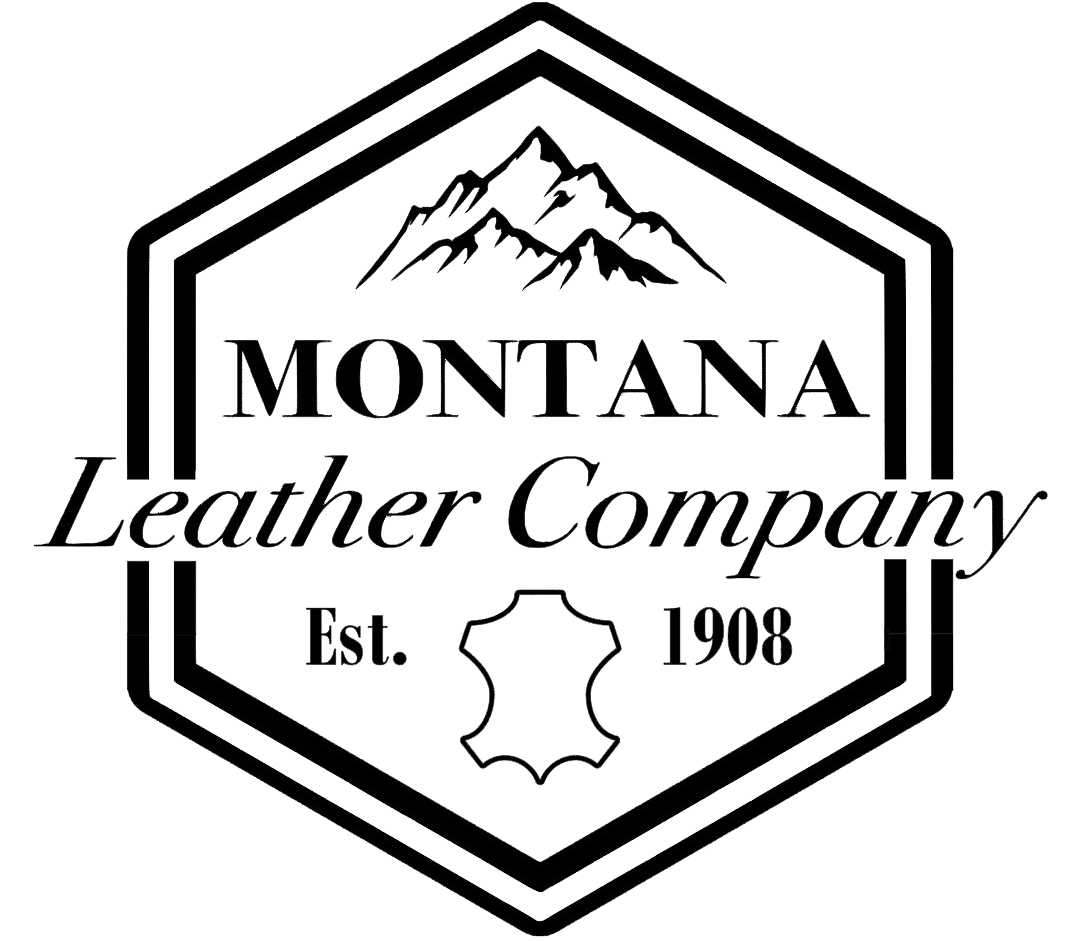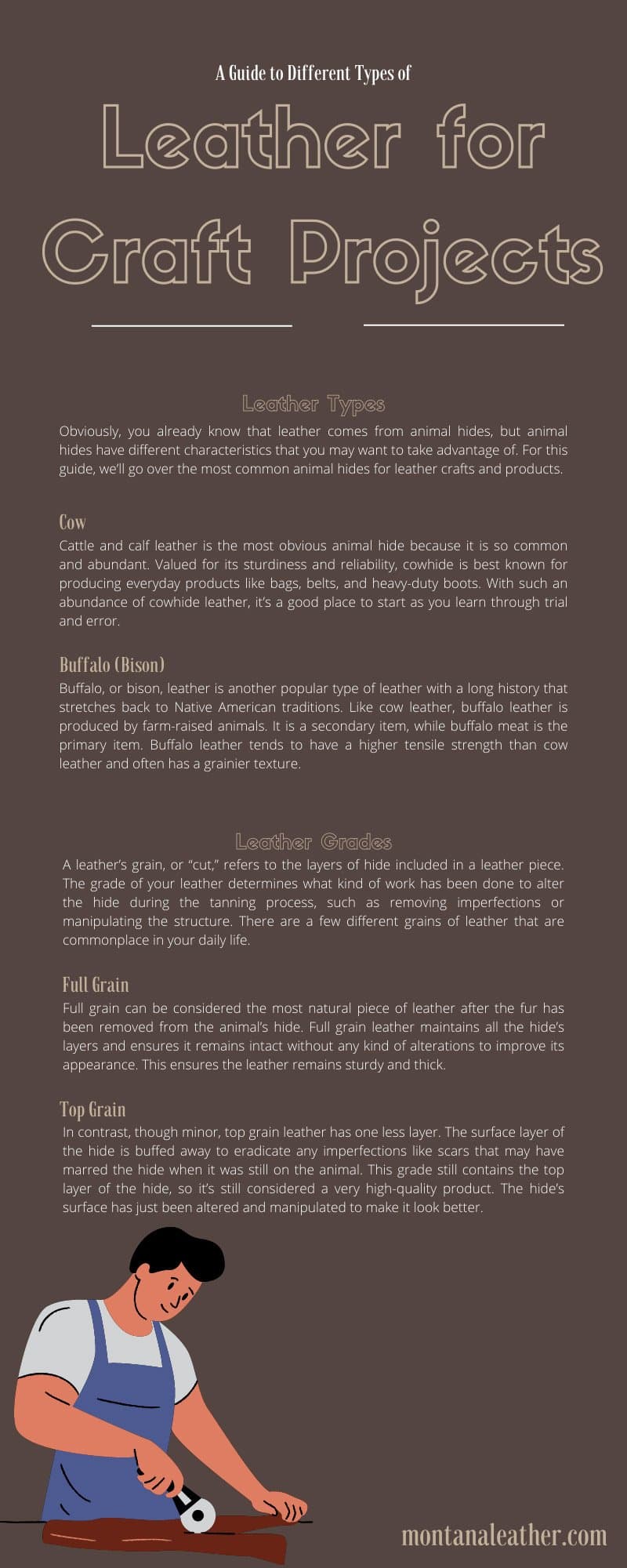
Leather is not only popular and highly valued, but it’s also one of the most plentiful materials available. This makes it a great material for people looking to pick up a new craft without worrying about not having enough supplies. But before you go and buy leather, you first need to understand the various kinds of leather at your disposal. Here is a guide to different types of leather for craft projects.
Leather Types
Obviously, you already know that leather comes from animal hides, but animal hides have different characteristics that you may want to take advantage of. For this guide, we’ll go over the most common animal hides for leather crafts and products.
Cow
Cowhide leather is the most obvious animal hide because it is so common and abundant. Valued for its sturdiness and reliability, cowhide is best known for producing everyday products like bags, belts, and heavy-duty boots. With such an abundance of cowhide leather, it’s a good place to start as you learn through trial and error.
Buffalo (Bison)
Bison leather, or buffalo as it is sometimes called, is another popular type of leather with a long history that stretches back to Native American traditions. Like cow leather, buffalo leather is produced by farm-raised animals. It is a secondary item, while buffalo meat is the primary item. Buffalo leather tends to have a higher tensile strength than cow leather and often has a grainier texture. At Montana Leather Company, we provide a wide assortment of buffalo leathers that can be used for bags, clothing, and more.
Deer
Deer leather is typically only chrome tanned these days. Unlike cow and bison, deer leather tends to come from the hunting trade, but there are exceptions to this with some deer farms. Typically, deer leather is very soft to the touch and is a great option for crafting gloves, moccasins, and clothing.
Elk
Elk leather, like deer, tends to come from hunters, so availability can be inconsistent. Even though elk also tends to be quite soft to the touch after its tanning process, elk leather tends to be thicker than deer. This leather is often used in traditional Native American attire, moccasins, garments, and bags.
Sheep
Sheep hide is incredibly popular in the apparel and shoe industries, thanks to its smooth texture. Furthermore, sheepskin leather is a favorite for colder climates because of the warm wool that is left attached to the leather. The wool itself is not only warm but well-loved for its fluffy and soft feeling that is often incorporated into the interiors of garments.
Pig
Not to be confused with good ol’ American football, pigskin usually comes from boars and is surprisingly soft to the touch. Pigskin leather is easy to identify because it’s uneven and features a pattern of three-dot clusters that isn’t found on other animal hides. Finally, pigskin leather is thinner and naturally waterproof, making it an excellent choice for shoes and clothing that must endure wet environments.
Goat
Also referred to as “Morocco Leather” in some parts of the world, goatskin leather is primarily used to make handbags, gloves, and clothing. In fact, goats make up 10 percent of the world’s leather. They provide soft material that is as useful as cow or sheep leather but lacks the sturdiness of cowhide and the warmth of sheepskin fur.
“Exotic” Leather
When one thinks of “exotic” leather, their first thought may be of expensive designer bags made from strange materials or advanced techniques. A wide range of animal hides fit under the category of “exotic,” including crocodile, alligator, ostrich, snake, eels, and even stingrays. The common factor here is that these hides aren’t easy to get ahold of and are not as common as typical animal hides, making them incredibly expensive.
Leather Grains
A leather’s grain, or “cut,” refers to the layers of hide included in a leather piece. The grade of your leather determines what kind of work has been done to alter the hide during the tanning process, such as removing imperfections or manipulating the structure. There are a few different grains of leather that are commonplace in your daily life.
Full Grain
Full grain can be considered the most natural piece of leather after the fur has been removed from the animal’s hide. Full grain leather maintains all the hide’s layers and ensures it remains intact without any kind of alterations to improve its appearance. This ensures the leather remains sturdy and thick.
Top Grain
In contrast, though minor, top grain leather has one less layer. The surface layer of the hide is buffed away to eradicate any imperfections like scars that may have marred the hide when it was still on the animal. This grade still contains the top layer of the hide, so it’s still considered a very high-quality product. The hide’s surface has just been altered and manipulated to make it look better.
Corrected Grain
To remove imperfections in corrected grain leather, the upper layers are taken off. The result is a naturally weaker product, although the strength is not important for use in linings, shoes, and other similar products.
Split Leather
Split leather is a type of leather that has had the upper layers buffed (nubuck) or removed (suede). Nubuck split leather will tend to have qualities more similar to top grain leather but with an obvious sanded finish. Suede split leather will almost always be ultra soft with a nap on both sides, which is great for garments, decorative elements, lace, or other items not intended for rugged use.
Bonded Leather
Lastly, bonded leather is the most compromised grade of leather available. Bonded leather takes the scraps of various other leather cuts to create a full product. What actual leather scraps remain are turned into a pulp with other materials that are then bonded into a leather lookalike. As a result, you can expect this to be the cheapest grade of leather.
Top Finish
The last element of our guide to the different types of leather for craft projects concerns the finish of your leather. Leather will be treated with one of two dyes to bring out the color and create a shine on the leather’s surface.
Aniline
Aniline is a dye that is typically applied only to napa leather, which refers to any kind of leather with an ultra soft texture. Aniline is a water-based dye applied to create a cohesive finish across your leather that still allows the natural grain of your material to show.
Natural
A leather with no finish at all has what we call a “natural” finish, or . Neither sleek nor shiny, natural leather has a matte luster and is quite common in elk, deer, and bison leathers.
Semi-Aniline
Containing much less pigment, semi-aniline dye functions like normal aniline dye but without being so overwhelmingly powerful. This allows tougher, non-Napa leather to maintain its unique features, such as marks, knots, and scars to create an attractive surface that is completely unique.
Familiarizing yourself with all the above terms and processes will make shopping for leather online a fast, easy, and fun experience. Leather crafting should always be fun, and that starts with buying the right piece for your project!

